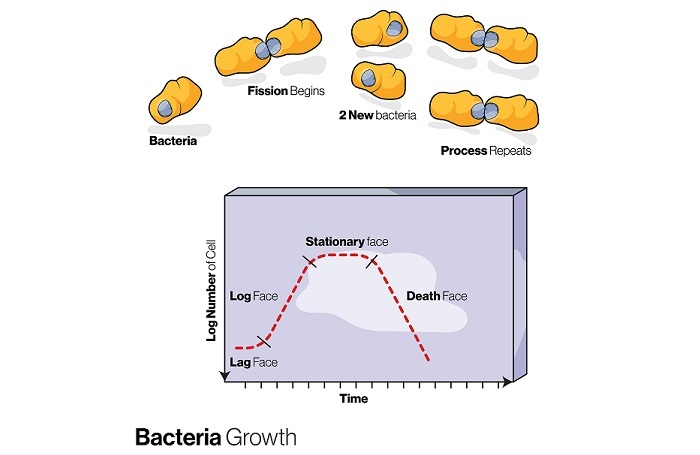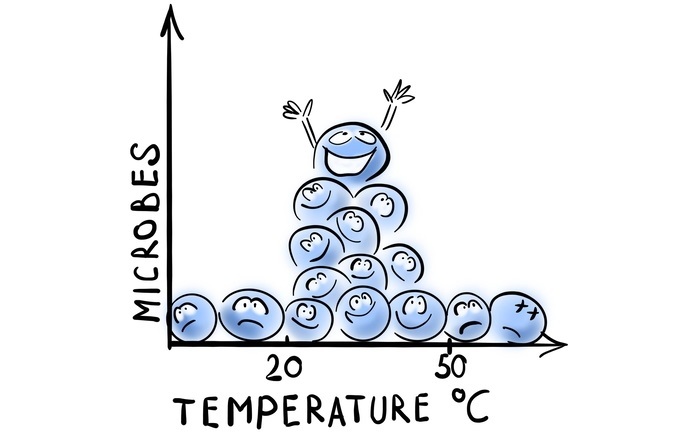
 Data Structure
Data Structure Networking
Networking RDBMS
RDBMS Operating System
Operating System Java
Java MS Excel
MS Excel iOS
iOS HTML
HTML CSS
CSS Android
Android Python
Python C Programming
C Programming C++
C++ C#
C# MongoDB
MongoDB MySQL
MySQL Javascript
Javascript PHP
PHP
- Selected Reading
- UPSC IAS Exams Notes
- Developer's Best Practices
- Questions and Answers
- Effective Resume Writing
- HR Interview Questions
- Computer Glossary
- Who is Who
What Are the Phases of the Bacterial Growth Curve?
An Insight
Bacterial growth curve is a graphical representation of the growth rate of bacteria in a closed environment. It provides us with a valuable insight into the life cycle of bacteria and their behaviour under different environmental conditions.
A typical bacterial growth curve consists of four phases ?
Lag phase.
Exponential phase.
Stationary phase.
Death phase.

Topic herewith discusses the phases in detail.
Lag Phase
The lag phase is the first phase of the bacterial growth curve. In this phase, bacteria are adjusting to their new environment and preparing for growth. During this phase, there is little to no increase in the number of bacteria as they are not yet actively dividing.
This phase can last from a few minutes to several hours, depending on the species of bacteria and the conditions of the environment. The lag phase is characterized by the synthesis of new enzymes, repair of damaged DNA, and adaptation to the new environment.
The length of the lag phase depends on the availability of nutrients, pH, temperature, and other environmental factors.
If the conditions are favourable, the lag phase will be shorter, and if the conditions are unfavourable, the lag phase will be longer. For example, if the bacteria are introduced into a nutrient-poor environment, the lag phase will be longer as the bacteria need to produce enzymes to break down the nutrients present in the environment.
Exponential Phase
The exponential phase, also known as the log phase, is the second phase of the bacterial growth curve. In this phase, the bacteria are actively dividing and replicating their DNA. The number of bacteria in the population increases exponentially, doubling at a constant rate. The rate of bacterial growth in this phase is determined by the availability of nutrients, temperature, pH, and other environmental factors.
The exponential phase is the most important phase of the bacterial growth curve as it is the phase of rapid growth. During this phase, the bacteria are at their most metabolically active and are producing large amounts of biomass.

Stationary Phase
The stationary phase is the third phase of the bacterial growth curve. In this phase, the rate of bacterial growth slows down and eventually stops due to the depletion of nutrients, accumulation of waste products, and other environmental factors.
During the stationary phase, the bacteria enter a state of dormancy or quiescence. This is a survival mechanism that allows the bacteria to conserve energy and resources during periods of environmental stress.
The stationary phase is characterized by the production of spores, the synthesis of stress response proteins, and the activation of mechanisms to repair DNA damage.
Death Phase
The death phase is the fourth and final phase of the bacterial growth curve. In this phase, the number of bacteria in the population decreases as the bacteria die off due to the depletion of nutrients and the accumulation of waste products.
The rate of bacterial death is faster than the rate of bacterial growth in the exponential phase, and the population eventually reaches zero. During the death phase, the bacteria undergo a process called autolysis, in which the bacterial cells break down and release their contents into the environment
Factors Affecting Bacterial Growth Curve
The bacterial growth curve is affected by several factors, including nutrient availability, temperature, pH, oxygen, and other environmental factors.
Nutrient Availability: The availability of nutrients is one of the most important factors that affect the bacterial growth curve. Bacteria require a source of carbon, nitrogen, and other essential nutrients to grow and reproduce. If the nutrients are scarce or unavailable, the bacterial growth rate will be slowed or halted.
Temperature: It plays a critical role in the bacterial growth curve. Each species of bacteria has an optimal growth temperature range, above or below which their growth rate is affected. At temperatures above the optimal range, bacterial growth may be inhibited or slowed down, and at temperatures below the optimal range, bacterial growth may be halted entirely.

pH: The acidity or alkalinity of the environment also affects bacterial growth. Each species of bacteria has an optimal pH range for growth, and any deviation from this range can affect their growth rate. Acidic environments can inhibit the growth of many bacteria, while alkaline environments can promote the growth of others.
Oxygen: Oxygen availability is another factor that affects the bacterial growth curve. Some bacteria require oxygen to grow and reproduce, while others are anaerobic and cannot tolerate oxygen. The availability of oxygen can affect the growth rate of both types of bacteria.
Other environmental factors: Other environmental factors, such as light, pressure, and radiation, can also affect the bacterial growth curve. Some bacteria require specific environmental conditions to grow, while others can adapt to a wide range of conditions.
Applications of Bacterial Growth Curve
The bacterial growth curve has several applications in various fields, including microbiology, food industry, and medicine.
Microbiology
The bacterial growth curve is an essential tool in microbiology, as it allows researchers to study the growth and behaviour of bacteria under different environmental conditions. This knowledge can be used to develop new antibiotics, vaccines, and other treatments for bacterial infections.
Food Industry
The bacterial growth curve is also used in the food industry to monitor and control the growth of microorganisms in food products. By understanding the growth curve of bacteria, food manufacturers can develop strategies to prevent spoilage and contamination of food products.
Conclusion
In conclusion, the bacterial growth curve is a valuable tool for understanding the growth and behaviour of bacteria in different environments.
The curve consists of four phases: lag phase, exponential phase, stationary phase, and death phase, each of which is characterized by different growth rates and metabolic activities.
The bacterial growth curve is affected by several factors and the knowledge gained from studying the bacterial growth curve has several applications in various fields, including microbiology, food industry, and medicine.

